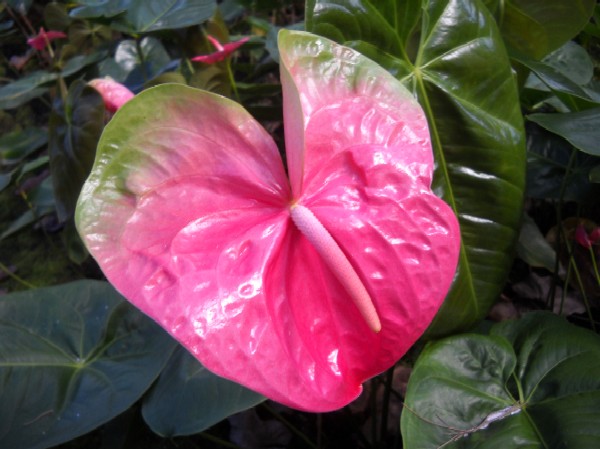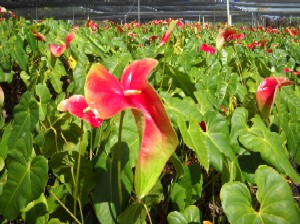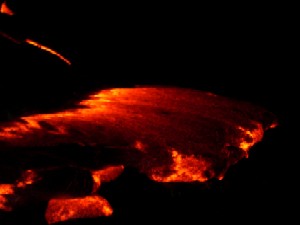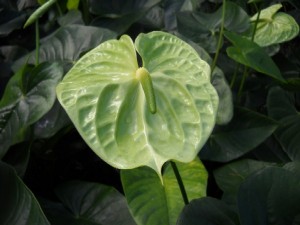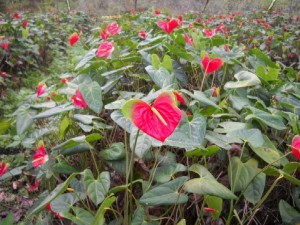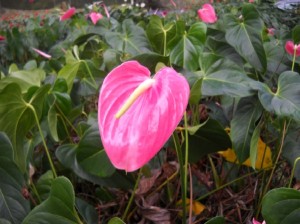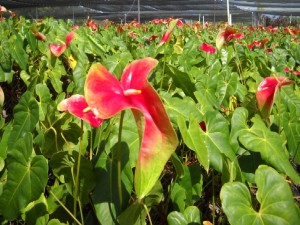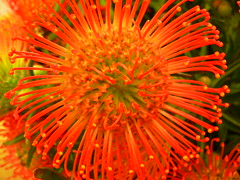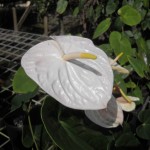Tatsuta Anthurium Picture
This is a picture of one of our Tatsuta anthuriums. Feel free to use this picture on your blog or website. All I ask is that you provide a link back to this web page.
Anthurium Flowers of Hawaii
Anthurium flowers aren’t native to Hawaii, but they have certainly made themselves at home here in our lush tropical paradise.
If you would like to buy anthurium flowers from Hawaii, please be sure to check out our anthurium flower catalog. But now, let’s get back to our story.
Anthurium Flowers: Where Do They Come From?
Before they decided to make a home for themselves among the volcanoes and beaches of Hawaii, anthuriums grew in the hot, humid rain forests of Central and South America. There they grew undisturbed for thousands of years.
Then one day in 1876 a man who would later become the head gardener of Paris, Edouard Andre, spotted a beautiful plant, while on a botanical expedition in the rain forests of Columbia.
It turned out that this plant was an anthurium plant.
How Did The Anthurium Get To Hawaii?
Edouard sent this magnificent specimen back to Europe and it first landed in Belgium. From Belgium, it was taken to the Kew Royal Botanic Gardens in England, (which claims to be one of the largest gardens in the world, containing one eighth of all the known plant species in the entire world.)
In 1889, Samuel Mills Damon, Hawaii’s Minister of Finance (and also Hawaii’s fourth largest landowner at the time) brought the first anthurium to Hawaii from England. He planted it in the gardens of his estate.
How The Anthurium Flower Developed in Hawaii
In the 1930s and 40s anthuriums spread from Damon’s estate all around Hawaii. Hobbyists began growing anthurium flowers in gardens and even their backyards, under Hapu’u tree ferns or tangerine trees.
The year 1936 was an important year for Hawaii’s anthurium flower industry. This was the year that a red anthurium which came to be known as the Ozaki was found in the garden O. Ozaki in the town of Hilo on the Big Island of Hawaii. At one point in time, the Ozaki was one of the best selling varieties of anthurium flowers from Hawaii.
1946 marked the discovery of a beautiful orange anthurium called the Nitta. It came from the garden of Asako Nitta and some say that is bears a striking resemblance to the original anthurium discovered by Edouard Andre.
In 1950, Haruyuki Kamemoto, returned to Hawaii after finishing his PhD at Cornell and launches the University of Hawaii‘s anthurium research program, which, as we will soon see, has a significant impact on the anthurium industry in Hawaii.
(As a side note, not only did Kamemoto have a huge impact on Hawaii’s anthurium industry, he also made major contributions to Hawaii’s orchid industry as well.)
1963 was another important year. It marked the release of the Uniwai white anthurium and the Marian Seefurth pink anthurium from the University of Hawaii. The Marian Seefurth anthurium was named after the wife of a man who made a very generous donation to the UH to fund anthurium research. These varieties were the first in a string of new anthurium varieties released by the University of Hawaii.
The Mauna Kea anthurium was released in 1977 by the UH. It is a large white and green obake anthurium variety.
In 1988, the first anthurium to be patented, the Starlight, which was developed by Calvin Hayashi, is introduced to Hawaii’s anthurium industry. It produces red flowers that are mottled with white specks. Mr. Hayashi also developed a dazzling green anthurium called the Midori.
In 1993, the University of Hawaii’s first patented anthurium is released. It is the Kalapana anthurium, which is a red and green obake anthurium flower. It is named after the magnificent black sand beach that was destroyed by a lava flow from the Kilauea Volcano.
Anthuriums on Amazon
Here are a few interesting anthurium related items that I saw on Amazon. I get a small commission from Amazon if you buy something through one of my links. The commission helps me to keep this site running and it doesn’t cost you any extra because Amazon already factors it into the price of all of its products.
Green Anthurium
Have green anthurium flowers or plants delivered right to your doorstep. We grow these green midori anthuriums on the slopes of the Kilauea Volcano. We sell flowers for $3.50 per stem and plants for $29 per top cutting. Click Here to Order Now.
Flowers
Midoris are one of the more durable anthurium flowers. They are slightly sturdier and a little more difficult to crease or bruise, so they hold up to shipping very nicely. They are also one of the longer lasting varieties and have a vase life of several weeks. When these flowers are left on the plant, rather than cut, they tend to develop reddish, copper colored highlights that can make them look even more attractive. The word “midori” is Japanese for the word “green,” so this is an apt moniker for them.
Plants
Green Midori anthuriums were developed by an anthurium breeder known as Calvin Hayashi in 1985. He did a very good job on this variety as they grow very energetically and their internodes are on the shorter side, so they aren’t as unwieldy as other varieties. We grow quite a number of these plants on our farm as their flowers are in very high demand.
Mickey Mouse Anthurium
Mickey Mouse Anthurium flowers are small red and green butterfly anthuriums. They have dark red centers and green “ears.” Perhaps they got their name from Disney’s famous mouse, but since his name is probably trademarked, I suspect they got their name from the pejorative slang term, which means small-time or trivial, instead. After all they are small in size.
But there’s nothing trivial about these flowers. They may be small, but they are still very beautiful. These anthurium plants like to throw off a lot of off shoots so one plant tends to multiply into several plants very quickly and may end up producing several stunning flowers at a time.
Pink Anthurium Flowers
Pink symbolizes grace and youthfulness. So Pink Anthurium Flowers make an ideal gift for a joyful friend who is the epitome of youthful innocence and gentility. Our flowers grow on a small farm on the island of Hawaii that is only a few miles away from the Kilauea Volcano. Each of these lovely Pink Anthuriums costs only $3.50 per stem. While our Pink Marian Seefurth Anthurium Plants are priced at $29 per top cutting.
Click Here To See Our Catalog.
Introduction
There are many varieties of pink anthurium. They can range in color from light pink to dark pink and they can be solid colored or mixed with other colors like white and green. You can even find then in standard, tulip, butterfly or obake shapes. Some of the amnicola hybrids are even blight resistant, so as you can see there is a great deal of variety in the pink anthurium category.
Obake varieties that are pink include Kimi, Anuenue and Le’ahi. Standard pink varieties consist of Marian Seefurth, Shibori and Blush Bride, while Lady Beth is the primary tulip variety. A pure pink obake does not exist, as by definition, obakes consist of two or more colors. The majority of pink obake varieties are colored pink and green.
Pink Anthurium Plants
Pink anthurium care is really straight forward. They require a growing environment that is heated between 70 and 80 degrees. Humidity should be as close to 100% as possible. They thrive on bright, but indirect sunlight. Full sunlight will burn their delicate flowers and leaves. When growing them in dry environments, mist them with water twice per day. This will give them the moisture that they require.
As long as your plants are in a potting soil that drains rapidly, they should be watered on a daily basis. You must ensure that any excess water is removed immediately. If your potting soil retains moisture you will have to be more judicious about watering, you will need to make sure that the soil dries slightly between waterings or your plant may experience root rot.
Prune away leaves that are turning yellow or dying, but make sure you don’t remove too many leaves. Fertilize once per year with a slow release 5-10-5 fertilizer or something close to that ratio. Use about a quarter of what is recommended on the label or less. Under fertilization is preferable to over fertilization.
Pink Anthurium Arrangments
In anthurium arrangements, pinks go well with many of the other pastel colors such as purple or green. They also look great with white colored varieties. The main thing to keep in mind is the relative size of the flowers. Tulips are small and should be arranged with other tulips, while obakes are large and should be arranged with other obakes. And of course standard pinks should be arranged with other medium sized standard varieties.
Kalapana Anthurium
Kalapana was a beautiful black sand beach in Hawaii that was known for its pounding surf and huge coconut trees. I say “was” because it no longer exists. Kalapana was consumed by fiery lava after the Kilauea volcano began erupting back in the eighties.
I suspect Kalapana obake anthurium flowers were named after this beach that was consumed by fire. Perhaps because they come in a fiery shade of red that might symbolize lava and they are tinged with green that might symbolize the coconut trees that used to grace this amazing beach that only exists in our memories and photos.
The Kalapana anthurium plant is a great plant to grow because it tends to be resistant to the blight, which is the bane of many varieties of anthuriums. And it also is resistant to anthracnose, which tends to destroy flowers.
And Kalapana is slowly being reborn as the waves tirelessly pulverize the new lava flow into ebony sand and gracious people replant tiny coconut seedlings one by one.
Hokuloa Anthurium
Hokuloa Anthurium Flowers were developed by the University of Hawaii. The university crossed an A. antioquiense with a Marian Seefurth to produce a hybrid. Then they took this hybrid and then crossed again with Tropic Mist. The end result was the Hokuloa Anthurium.
The Hokuloa anthurium flower comes in a gorgeous shade of white. It has a yellow nose that turns white as the flower matures.
Did you know that Hokuloa means morning star in Hawaiian? And of course morning star is a reference to the planet Venus, which is one of the brightest objects in the sky. Venus manages to outshine all of the stars in the sky by reflecting massive amounts of sunlight towards us.
The Hokuloa is almost as brilliant as its namesake. Its flowers are almost resplendent enough to blind you if you don’t wear sunglasses. (Okay, maybe I’m going a little overboard, but it is a beautiful flower.)
Tropical Wedding Bouquets: A Guide to Hawaiian Flowers for Bridal Bouquets
Planning a wedding is tough and selecting the perfect bridal bouquet from a huge catalog of tropical wedding bouquets can be a daunting task. But it doesn’t have to be.
First you must decide which exotic flower you like best. Once you have done this, your choices will be narrowed down dramatically. And from there it is a much simpler task to choose the perfect bouquet for your wedding ceremony.
To help you choose the focal flower of your bouquet, I am going to go over the most popular Hawaiian flowers and once you know the options that you have available this should help to make your decision easier.
I think that you’ll be really pleased by your decision to go with a tropical wedding bouquet because they come in brighter colors, are available year round and they look really chic, hip and modern. After all, who wants to be old-fashioned?
Anthurium
Beautiful anthurium flowers are the epitome of love. They are even shaped like hearts. They come in a huge range of colors and sizes as you can see in this picture of just a few of the varieties of colors from our farm. You should be able to match them to almost any color scheme that you have planned for your wedding as the come in pink, red, orange, green, white, purple, lavender and many other solid and mixed colors.
Plumeria
Plumeria are some of the sweetest smelling flowers that you could use in your bouquet. Some would say that they smell even better than roses and their scent can be very intoxicating. They can be found in a variety of colors, including yellow, pink, gold, orange and red.
Pincushion Protea
If you really want to push the boundaries in your bouquet, you might want to consider these bizarre looking flowers. I might call them bizarre, but they are actually very beautiful they just look different than just about every other tropical flower in the world and they really stand out. They kind of look like pincushions with pins sticking out or perhaps like giant versions of the carnivorous sundew plant, but they are exceptionally beautiful and they don’t bite.
Orchids
Of course the old stand-by, when it comes to tropical bouquets is orchid flowers. You can go with Dendrobiums, Cymbidiums or Phalaenopsis. They all look exquisitely beautiful and have a timeless beauty. They would look just as amazing in your wedding today, as they did back in the 1800s, when they were first brought to Europe by some of history’s greatest explorers.
Bird of Paradise
These enticing flowers received their unusual name because they evoked images of brightly colored birds in flight. With their yellow and orange petals, they almost look like they are on fire and they really create a visual statement against the backdrop of a white wedding dress. They are sure to cause a sensation at your wedding.
So now that you have seen the types of tropical flowers that can be used in your wedding bouquet, all you need to do to narrow the field down is first, consider which flowers come in the colors you have planned for your wedding. And second, just choose a flower that strikes your fancy. That is all there is to it.
Anthurium Colors: A Guide To Anthurium Flower Colors
Anthurium flowers from Hawaii come in many different colors. Here are a few of my favorite anthurium colors.
Purple is a newer color for anthuriums. Most of the colors you see today were developed after the 1940s and purple is even newer than that, it was developed sometime around 1980. Most purple anthurium plants produce a stunning tulip shaped flower in a very pleasing shade of purple.
White is an interesting color. If you take all of the colors of the rainbow and you blend them together you get white. White anthurium flowers were created by crossing a number of different anthurium species together. In fact, a white anthurium hybrid called White Lady is the product of four different species which were crossed together in 1987.
Pink is a very popular color and there are many varieties of pink anthurium. They can range in color from light pink to dark pink and they can be solid colored or mixed with other colors like white and green. You can even find then in standard, tulip, butterfly or obake shapes. Some of the pink amnicola hybrids are even blight resistant, so they are much easier to grow than other colors of anthuriums.
Green anthuriums were created by a grower named Calvin Hayashi in 1985, right here, on the Big Island of Hawaii. There are other varieties that may have some green in them or possess an off shade of green, but only the Midori is solid green. I believe that the Midori is one of the most innovative varieties as it was the first and still the only variety of anthurium that is completely green.
Red is the most popular color for anthuriums and there are a number of varieties of reds. Varieties include: Kozohara, Ozaki, Starlight Red, Princess Lily and New Pahoa Red. The Kozohara and Ozaki are among the older varieties and the other varieties are slightly newer. The major weakness of the red varieties is that many of them are highly susceptible to bacterial blight, though the University of Hawaii and other breeders have been hard at work at creating blight tolerant varieties.
White Anthurium
White is an interesting color. When you take all of the colors of the rainbow and you blend them together you get the color white. White anthurium flowers were created by mixing a number of different anthurium species together. In fact, a white anthurium hybrid called White Lady is the product of four different species which were crossed together in 1987.White Lady is an excellent plant to grow at home, because it makes a great potted plant. It is a very compact plant so it is capable of growing in a small pot in a small amount of space. It is also a very hardy plant and in fact it also demonstrates resistance to the bacterial blight. If treated well, it will produce six elongated tulip shaped flowers a year. These lovely flowers will acquire a slight hint of pink as the flowers mature. If you put these flowers into a vase, they will last up to 25 days.
Other white and off-white varieties include: Pua Kea, Ellison, Sister Grace and Limelight. Most of these types of flowers fall into the standard anthurium family as opposed to the tulip anthurium family like White Lady. Standard anthuriums are medium sized flowers that are heart shaped, while tulip anthuriums are smaller and of course tulip shaped. Tulip anthuriums are usually hybrids of the anthurium amnicola species, while standard anthuriums are generally hybrids of the anthurium andraeanum species.
White anthurium care is very straightforward. Put them near a sunny window, but do not allow them to receive full-strength sunlight or they will get sun burned. Make sure that they are kept at a temperature of 70 to 80 degrees. Water them regularly, but make sure that their soil is always well drained. Apply a small amount of slow release fertilizer once or twice a year. And that is pretty much all there is to it.
White anthurium flowers can be arranged in a number of ways. A simple arrangement could consist of 6 to 12 flowers all by themselves. More complex arrangements could consist of pinks and whites; or whites, pinks and reds. You could also mix them with other flowers. They go really well with orchids and green tropical foliage. If you really want to push the envelope, you could arrangement them with red anthuriums, lilies and roses, as well.

